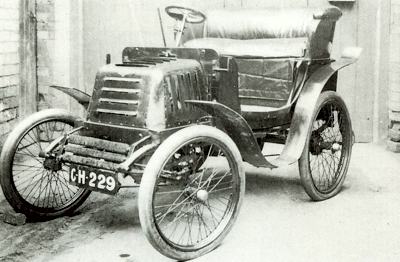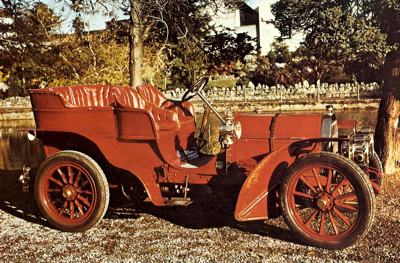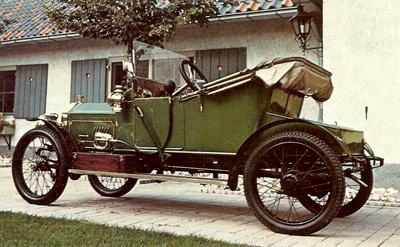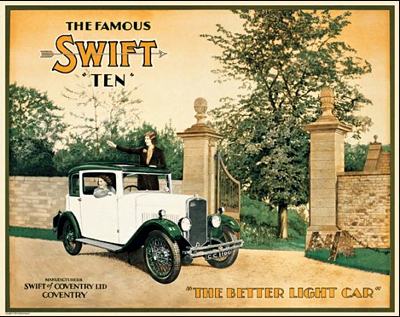The European Sewing Machine Company
From 1869, the European Sewing Machine Company had been supplementing its 'Swift-sure Sewing Machines' with the first English 'boneshaker' velocipedes. To cover its new range of activities the firm's name was soon altered to Coventry Machinists' Company, and in 1870 they built the very first high wheeled 'ordinary' or 'penny farthing' bicycle to the designs of James Starley, the 'father of the cycle industry'.
The Swift Voiturette
Though Swift became one of the leading manufacturers of bicycles, they were late to enter the motor car field. When they did, in 1902, it was with a strangely designed vehicle. The unlovely voiturette was powered by a 4
½ hp single-cylinder engine of the De Dion type supplied by the Motor Manufacturing Company. The gear change was novel, with two sets of teeth on the crown wheel and two pinions, the choice of gear ratio being determined by dog clutches. To start the voiturette the driver had to insert the crank-handle into a hole on the (unsprung) rear axle.
The car was as unreliable as its specifications suggested, and it was not long before a more orthodox single cylinder Swift appeared, to be joined by a 10 hp model with a Swift-built twin-cylinder engine in 1904. Subsequently, three-and four-cylinder models were added to the range, and the marque began to score successes in the major reliability trials of the day.
The RAC Thousand Mile Reliability Trial
In 1903 a Swift took a silver medal in the RAC Thousand Mile Reliability Trial, in their 1904 600-mile event a Swift was awarded a gold medal. In 1905 one of the new four-cylinder 16/20 hp Swifts competed for the RAC Tourist Trophy. It made an impressive non-stop run achieving the lowest petrol consumption of any of the four-cylinder vehicles in the competition at 26
½ miles per gallon.
The South Indian Official Reliability Trials
The following year, a Swift beat all-comers in the South Indian Official Reliability Trials, achieving maximum marks in all categories of the event-reliability, speed on hills, ease of control, petrol consumption and engine power - and was awarded the India Cup. In the Scottish Trials that year another Swift swept the board, winning a gold medal for achieving 995
½ marks out of a possible 1000, a figure well ahead of any other car in the trials, irrespective of price, class or horse-power, and recording a fuel consumption of 36.04mpg.
The World's Record for Reliability
In 1907 a Swift again won a gold medal in the Scottish Trials; the marque also received a gold medal and the highest possible marks for its performance in the Irish Reliability Trials. It might seem difficult to improve on these performances, but in 1908 Swift did just that, taking 999.2 marks out of 1000 in the Scottish Reliability Trials, making it three golds in a row in this event, which Swift claimed as the 'world's record for reliability'. A team of three Swifts was entered for the Irish Reliability Trials and triumphantly carried off three gold medals, the team challenge cup, and 2548 marks out of a possible 2550, a brilliant performance.
 The original 1902 Swift.
The original 1902 Swift.
 1903 Swift Tourer 4 Seater, powered by a four-cylinder engine developing 50 bhp.
1903 Swift Tourer 4 Seater, powered by a four-cylinder engine developing 50 bhp.
 1913 Swift Runabout.
1913 Swift Runabout.
 1913 Swift 10 HP.
1913 Swift 10 HP. |
It was at this point that Swift wisely decided to quit while they were still ahead of the game, commenting: 'When in 1908 Swifts secured the Scottish Trials Gold Medal for the third year in succession, the "Daily News" remarked, "The Swift might retire now and give someone else a chance." We took this advice for 1909 (especially as we had in as many orders as we could execute), and it is worthy of note that, although the climatic conditions were vastly improved, no car in the 1909 trials, irrespective of class, price, or horse-power, was able to approach the 1908 record of the 10-12 hp Swift.'
A Good Small Car
In 1909, the company announced 'a good small car', a 7 hp single-cylinder, also marketed by the Austin Motor Company. Swift described the new model thus: 'Many would commence motoring if only assured of a good car at or about £150. Price difficulty no longer exists, for it is now possible to obtain a car embodying the highest standard in design combined with the best material and workmanship at the moderate price of £147 complete. The production of this car has been based on nine years actual manufacturing experience of good, reliable cars. Exhaustive tests have been carried out, so that today we are in a position to recommend this car with the utmost confidence, for it is not only soundly constructed and thoroughly reliable, but it is inexpensive to run and maintain.'
Admirably Suited to a Doctor's Requirements
However, even by the standards of 1910, the little Swift was totally outdated from the start, as the motoring public had been educated to expect something more refined from a light car than a badly balanced single-cylinder engine of 1100cc and the good small car was out of production within a couple of years. Also included in the 1910 range were the 10/12 hp two-cylinder 1814cc, which was claimed to be 'admirably suited to a doctor's requirements ... a large percentage of the total output of this type of car has passed into the hands of the medical profession, and letters are continually being received testifying to the all-round excellence of this type of vehicle as ideal for medical work.'
A long wheel-base version of this car could carry a four-seater touring body. Then there was the 2315 cc 15/ I 8 hp model, 'a handsomely appointed first class four-cylinder touring car' and the 3628 cc 18/24 hp, 'a luxuriously appointed car, embracing all that is best in a high-class powerful touring vehicle'. There was also a low-geared, long-wheelbase version of this model, 'a splendid car for town use, specially adapted for town and theatre work'.
The 1912 Motor Cycle and Cyclecar Show at Olympia
By 1913 the model line up had become even more complex, when the Swift company announced: 'The one thing that was needed to complete Motor History.' This was the 972cc vertical twin cyclecar launched at the 1912 Motor Cycle and Cyclecar Show at Olympia. This model, which definitely did not make motoring history, became the smallest of a range otherwise consisting of a 1327cc 10 hp, a 1795cc 11.9 hp, a 1945cc 14hp, a 2614cc 15.9 hp and a 3054cc 20 hp, which for the time was a very wide range. Only the 12 survived the war, and that for only a short while; it was joined at the 1919 Motor Show by an updated version of the 10 hp model.
The Swift cars of the 1920s were uniformly four-cylindered, conservative in design and unremarkable in terms of power output. The specification of the 10 was mildly updated in 1923, when the engine acquired a detachable cylinder head and a gearbox built in unit. For 1926, the 1097cc ten and the 12/35 hp, of 1954cc, acquired four-wheel brakes; the following year, presumably to justify the fitting of all round brakes to cope with its somewhat lethargic performance, the 12/35 was uprated to the more fashionably middle class horsepower rating of 14/40, though engine design and capacity were unchanged.
The Migrant Sun or Shade Saloon
By the end of the decade the 'sturdy ten' was the backbone of Swift production, which probably never exceeded 2000 units a year at its peak. At the end of 1928 a novel body style was offered on the 10 hp chassis. The Migrant Sun or Shade Saloon, which at a price of £270 offered two sunshine roofs, one for the front seats, one for the back, both of which could be rolled back independently. For 1930, the Ten was once again modernised with a narrow shell ribbon radiator and four-speed gear-box, a specification which was further improved for 1931 with a rear-mounted petrol tank, hydraulic shock absorbers, big-hub wire wheels, dipping headlamps a central chrome bar on the radiator shell and a new type of flush fitting sliding roof. More traditional was the Ten's retention of right-hand gear change. Prices ranged from £250 for the three-seater drop-head coupe and the Nomad saloon to £295 for the Fleetwing fabric saloon on a specially tuned chassis.
The Swift Cadet
Swift were losing out against mass producers like Morris and Austin who could afford to keep prices down as a result of large scale production; and they made the mistake of trying to take the fight up to the competition in a price war. At the 1930 Olympia Motor Show came the announcement of a new 847cc model, 'the Aristocrat of the Small Car World, the Swift Cadet - a car of individuality, taste and distinction - of limitless usefulness and enjoyment - and withal a moderate price.' But at £160 the open tourer version of the Cadet was £20 more expensive than a coach-built saloon on the Morris Minor chassis of identical engine size, while the Cadet saloon, at £185, was definitely over-priced. The Cadet was certainly not the car to revive the flagging fortunes of Swift which continued to fail until, in 1932, the marque was dead.
